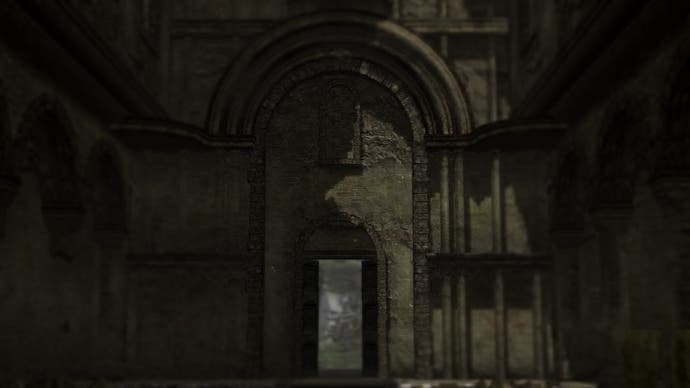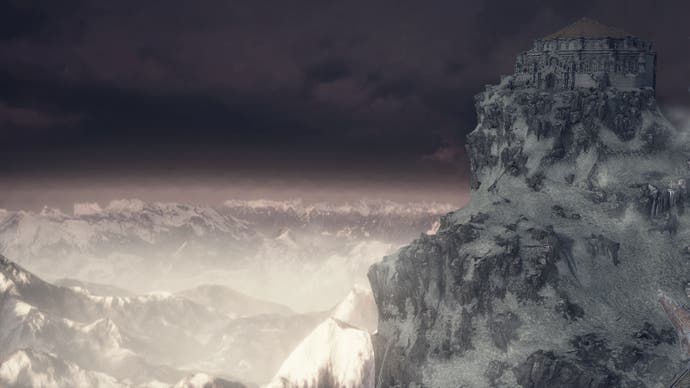An obituary for the architecture of Dark Souls' eternally dying land
Apocalypse forever.
Editor's note: We're delighted to welcome back Gareth, the editor of the fascinating new zine Heterotopias, for another piece exploring the intersection between architecture and video games. You can find his last piece on Resident Evil's mansion here, and find a copy of the second issue of Heterotopias over here.
"In this land, the undead are corralled and led to the North, where they are locked away to await the end of the world." This was the line that gripped me when I started up Dark Souls for the first time in late 2011. It's a line I've found myself returning to again and again when I try to conjure up the particular quality of Dark Souls' world that makes it so enticing. Not that enough thought and words haven't been expended on the series already: over its six year history, which if From Software are to believed marks both its beginning and end, the writing, debates and other games the series can have said to inspired makes for an impressive volume of work. Even the game's architecture, my subject specialty, feels like it has been dissected from many angles, its gothic arches and vaults often connected to many different histories of horror and the sublime. However, even with all this activity around the series, it feels necessary, with the final DLC of the final game The Ringed City having passed and settled into its place, to write an obituary of sorts for its particular collection of spaces and structures, at least before the predictable resurrection that the game's financial success and avid fan base will surely trigger.
The reason I say obituary is because for me, the depiction of architecture in Dark Souls orbits around one central theme: death. Let's go back to that first line: its poetry lies in the idea of the undead not as rampaging monsters, or mystical beings, but as the cursed; those who have been denied death. Without the comfort of inevitable death, there is only one end that awaits them: the end of all things. And what really makes that line stick in my mind is how it combines this erasure of death with a distinct sense of space. The reference to a kingdom or a "land", the icy, distant presence of the word "North" and the hollow prisons suggested by the phrase "locked away" give an overriding sense of architecture, and its function as a prison, a refuge, or a container for the dead. This line points to the central architectural image of the series: a crumbling edifice in which the deathless wander, meaning sapped by time from both the undead's decaying bodies and the stones that encase them.

This idea of architecture as a container for the dead has an ancient history. Howard Colvin, one of the great architectural historians pointed out that "architecture in Western Europe begins with tombs" pointing to the neolithic funereal monuments, hewn in rough stone, which have been part of our landscape for more than 12,000 years. However the connection is not only a historical one: Alfred Loos, one of the most influential theorists of Modern architecture, found something essential in the connection between architecture and death, writing "if we were to come across a mound in the woods, six foot long by three foot wide, with the soil piled up in a pyramid, a somber mood would come over us and a voice inside us would say, 'There is someone buried here.' That is architecture."
Here Loos is referring to the ability or architecture to create and change space: a blank field, when filled with headstones, becomes charged with meaning, atmosphere and power. But he is also suggesting that the connection between death and architecture is not just one of pragmatism-that the dead have to be put somewhere, but is instead one of symbolism-the tomb as a structure is both a container of the dead, and an affirmation and symbol of life. It is a marker that its resident once lived. In this sense the tomb is perhaps the mirror twin of the room, a space designed to hold life, but that in its dead, empty, decaying form serves as a reminder of death. As the dying man in Vladimir Nabokov's short story Terra Incognita realises in his final moments "the scenery of death" is little more than "a few pieces of realistic furniture and four walls."

Yet in Dark Souls' world these divisions between life and death have become lost, and so it follows too that the binary of tomb and room might be lost also. The spaces of the Dark Souls series are eternally caught in a state of undeath, between collapse and continuance. Every architectural space in the series seems to oscillate between the state of tomb and room. Take the new Londo ruins, for example, a series of hollow voids above a lake that is later to be revealed to be the container for countless corpses, concealed out of sight. Or the Undead Crypt in Dark Souls 2, a vast funerary complex of monumental tomb architecture that at its heart hides the lands ruler not in the form of a corpse, but as an immortal living being, pacing his own crypt as if it was his throne room, awaiting, like the undead of the first games asylum, the end of the world. Of course, in Dark Souls' case, the end of the world has already arrived. The Ringed City DLC, which this year marked the end of the series in both a fictional and real sense, invited players to "journey to the world's end," to descend into the first and last city. In the game, when we approach the Ringed City itself, we see it circled by a vast stone wall, just like the wall that obscures the city of Anor Londo in the first Dark Souls. And looking on this vast walled city I was brought back once again to my first experiences with the series, experiences that might instruct another way of considering its architecture.
It's no coincidence that my Dark Souls character is and always will be named Steerpike. As the antihero of Mervyn Peake's incredible three volume gothic masterpiece, Gormenghast, his was the first name that came to mind when I set eyes on the vast rock wall of Anor Londo and the void below from the crumbling vantage point of Firelink Shrine. In Peake's world, an impossibly vast castle plays host to scattered generations of royalty and their servants, all locked in senseless rituals that guide them like nomads amongst overgrown halls and abandoned apartments. In his books Peake casts architecture as a weighty burden, a physical realisation of tradition, ritual and history that its inhabitants must try, and fail, to maintain and make sense of. The castle of Gormenghast is a vast undead corpse, returning to nature. Not a corpse of a single human however, but the corpse of an entire civilisation falling into ruin. Take Peake's first description of the castle itself: He talks of the "shadows of time-eaten buttresses, of broken and lofty turrets" but perhaps the most striking feature is the way he describes the vast central "Tower of Flints" as rising "like a mutilated finger from amongst the fists of knuckled masonry and pointed blasphemously at heaven. At night the owls made of it an echoing throat; by day it stood voiceless and cast its long shadow." This anthropomorphic description isn't trying to suggest that Gormenghast might be a character in the novel, instead it is presenting it as a body; a voiceless, mutilated, blasphemous body. A body who must await the end of the world in order to truly die.

In evoking the connection of Dark Soul's architecture to Gormenghast, the Ringed City suggests to me that the spaces of Dark Souls too could be thought of it the same way. They are perhaps the mirror image, not of the tomb or room, but of the bodies they contain. Like the series' "hollows" a profoundly architectural name for the undead, the architecture of the Dark Souls' series is, more than a container for walking corpses, and is instead a withering, putrefying, deathless corpse in itself. Its spaces, the cathedrals, castles, caves, sewers, fortifications and forest huts of Dark Souls and its sequels are hollow bodies, locked in processes of organic decay. A descent through the Ringed City only seems to strengthen this idea: it is a structure which at its highest point is drained of color, dry and calcified, but as you descend becomes fetid, waterlogged, sinking into its own fluids. At its base, it is infested with insects and parasites, its buildings pointing haphazardly up out of a congealed swamp. This imagery is something that can be traced through the series: the lowest point of the original game is the Ash Lake, a vast interior filled with branching structures like the interior of a set of calcified lungs, while the depths of Dark Souls 2 hide the Black Gulch, home of The Rotten, a literal living structure of undead corpses. Even when we return to Anor Londo Dark Souls 3, we find it decaying into a putrefied, black murk, as if it was not made of steel and stone, but some organic material that mirrors their properties.
And yet, whether we see the architecture of the Dark Souls series through the lens of both tomb and room, or as a vast decaying corpse, there is a contradiction we must accept. The spaces of Dark Souls, from its cathedrals to its humble huts, are cursed to remain ruins forever. As virtual spaces, these seemingly shattered structures are in fact fashioned as ruins by From Software's exceptionally talented artists, their collapse frozen in single frames of beautiful decay. They are ultimately without a past or a future. They will never give in to entropy, erosion and time, and be erased from the landscape, and neither can they possess a true golden past, a moment when they were total, complete, unbroken. They were built as ruins and as ruins they will stay, so that in a thousand years we might return to these spaces and find them as we left them, in collapse but never collapsing, gesturing towards an end of the world that has, improbably, both arrived and yet will never come.

